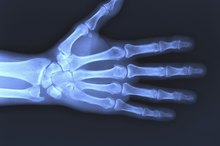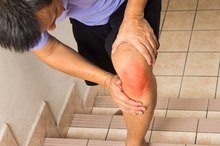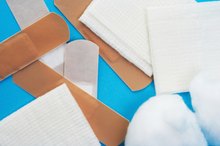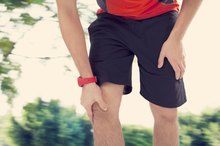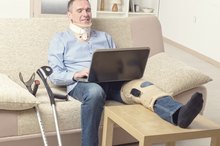What does fact checked mean?
At Healthfully, we strive to deliver objective content that is accurate and up-to-date. Our team periodically reviews articles in order to ensure content quality. The sources cited below consist of evidence from peer-reviewed journals, prominent medical organizations, academic associations, and government data.
The information contained on this site is for informational purposes only, and should not be used as a substitute for the advice of a professional health care provider. Please check with the appropriate physician regarding health questions and concerns. Although we strive to deliver accurate and up-to-date information, no guarantee to that effect is made.
How to Drain Fluid From a Knee
The knee is the largest joint in the human body, and is notoriously prone to injury due to the complex nature of the movements it makes and the stress it endures 1. The kneecap is not "fixed" to the upper or lower leg, but rather "floats" in a network of soft tissues, tendons and ligaments. Because the knee can twist, rotate, bend and straighten, it sustains the brunt of most of the pressure during hard physical activities. When injury occurs, the first reaction of the knee is to swell. This swelling can become quite extreme, and may need to be aspirated in order to help the joint heal.
If you are experiencing serious medical symptoms, seek emergency treatment immediately.
Go to a doctor. Only a medical doctor should perform this procedure. Aspiration involves the puncturing of the joint capsule, and if done improperly, damage can occur, as well as deadly infection. The remainder of the steps are addressed to doctors learning the procedure.
Arthrogram Side Effects
Learn More
Swab the entire knee joint with the Betadine solution 1. From mid-shin to mid-thigh, scrub the skin thoroughly with the cleanser and pat dry with sterile gauze.
Swab the injection sites with an alcohol pad, and inject the local anesthetic in the area surrounding the knee joint 1. Make sure the area is sufficiently numb by applying some painful stimulus to the area without any feeling.
Complications From Arthroscopic Knee Surgery
Learn More
Insert the bore needle (20 gauge) into the middle of the knee joint and slowly draw back the plunger to remove the excess fluid 1. Manipulate the knee to get as much of the fluid as possible. It may be necessary to change syringes if one fills up.
Carefully remove the bore needle and swab the site with alcohol. Apply pressure to the injection site for a couple of minutes, then apply a sterile dressing.
Tips
Stay off the knee for at least 24 hours after this procedure in order to allow it to fully recover.
Warnings
Never, under any circumstances, attempt to do this yourself, or allow anyone except a medical doctor to perform this procedure.
Related Articles
References
- Knee Joint Injections and Aspirations
- American Academy of Orthopaedic Surgeons: OrthoInfo. Common Knee Injuries.
- U.S. National Library of Medicine: MedlinePlus. Meniscus tears–aftercare.
- American Academy of Orthpaedic Surgeons: Ortho Info. Synovial Chondromatosis.
- National Institute of Health: News in Health. Beating Bursitis: Take Care of Your Joint Cushions.
- U.S. National Library of Medicine: MedlinePlus. Knee Injuries.
- Bronstein RD, Schaffer JC. Physical Examination of the Knee: Meniscus, Cartilage, and Patellofemoral Conditions. J Am Acad Orthop Surg. 2017;25(5):365-374. doi:10.5435/JAAOS-D-15-00464
Tips
- Stay off the knee for at least 24 hours after this procedure in order to allow it to fully recover.
Warnings
- Never, under any circumstances, attempt to do this yourself, or allow anyone except a medical doctor to perform this procedure.
